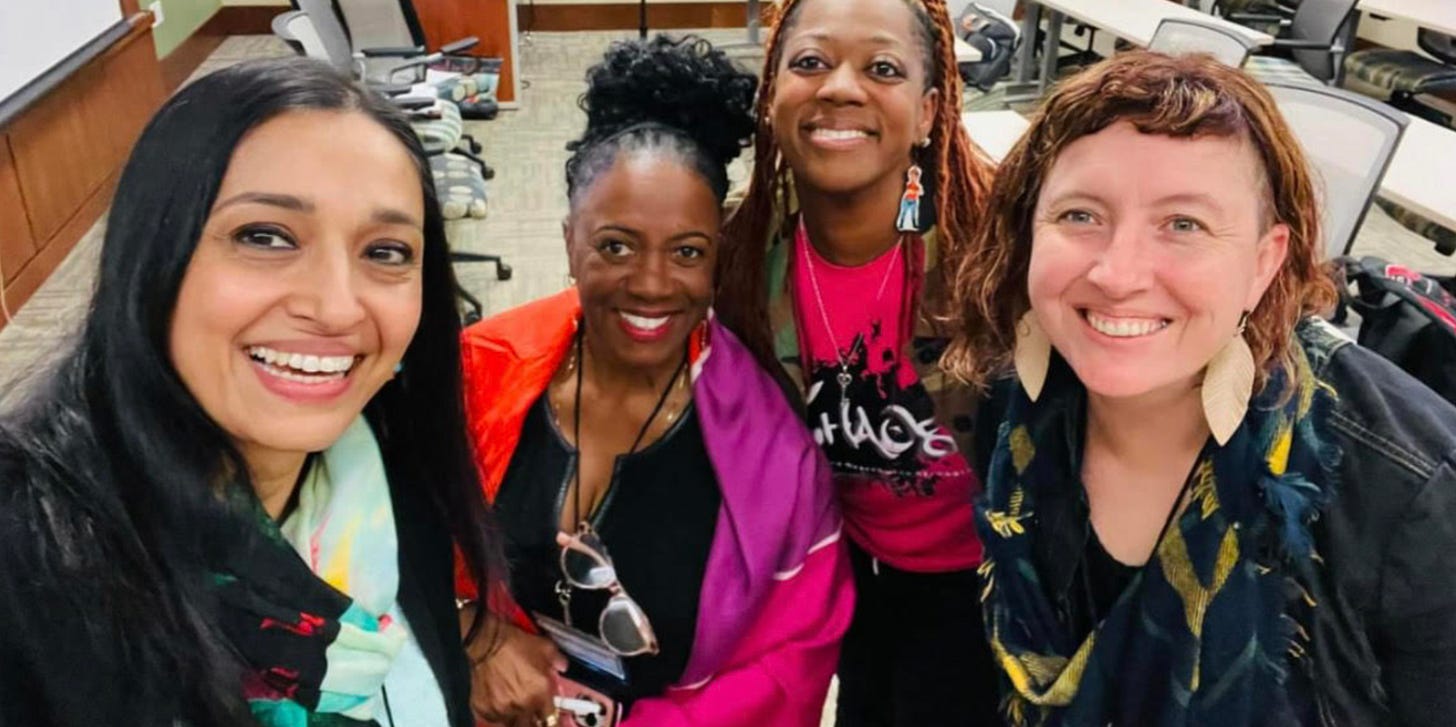Blog: How Community Shapes Trauma-Informed Leadership
Strategies and insight from our Affinity Group Members, Sarah and Sarit
Written by Sarah O’Brien, Featuring: Sarit Zimmerman Rogers
The Missing Piece in Professional Training: Practice and Application
Ever taken a training course? Continuing education training? Seminar? Conference? If you’re in the professional workforce, you probably have. If you hold a license to work or practice of any kind, you definitely have. There is great knowledge and information in these types of things, no denying that. However, there is something missing…a pretty big something is missing. Application. Practice. Time to DO whatever thing you LEARNED in that training, seminar or conference. Now, I’m a Licensed Clinical Social Worker, and I will say, there have been many trainings or seminars where the presenter, likely also an LCSW, has provided application for the information they are presenting. This is good. It’s a step. It’s not everything though. And it’s not really what I’m referring to here.
How does one actually gain new skills and not just new knowledge? This is what I’m referring to. I’ll be honest, it’s a little scary to me that clinical providers (of any kind!) are not required to demonstrate an understanding of the new knowledge outside of completing simple quizzes on the information. Even scarier, is that there is zero requirement to demonstrate application of the knowledge in real time with real people—clients, patients. I understand the complexity of indoctrinating an oversight such as this. However, if adopted, this would elevate clinical care to the Nth degree. Why? Because applying skills learned to the work you do with people IS THE ENTIRE POINT of learning new things for your field. Especially if you’re in the people business, in the services to people business, and definitely in healthcare.
Building Better Leaders Through Practice and Real-Time Feedback
Where else is this applicable? Leadership. (Although I would say that any healthcare provider is indeed in a position of leadership, leading the care for their patients). How many times have you witnessed a person get promoted into a leadership position without any leadership experience? Or has a requirement to get leadership training either before or right after they’re hired for said leadership position? Or has a requirement to continue learning skills for their leadership position? Or has been removed from their leadership position because they in fact don’t lead well, cause harm while doing it, or just straight up have no idea how to lead? Yea. Right. Same. Like, almost never. On all accounts.
This is a problem. It should be alarming for everyone.
Whether appointed, hired, or promoted, persons in positions of leadership SHOULD BE well-equipped to lead—and lead well—before being permitted to do so. Especially if they are a people-leader. In the people business. In the services for people business. Which, in case it hasn’t occurred to you, is practically every job everywhere. Now, how do we know if someone is well-equipped to lead, guide, teach, assist others? By observing them do it! In real time, with real people, in whatever field or industry they are in. If a person is to be promoted to manager or supervisor, they need time to practice, and receive feedback, before taking over. Even better, would be ongoing support, guidance and feedback about HOW they are leading throughout their tenure as leader (manager, supervisor, etc). You can’t really practice by yourself. You can’t really know how you’re doing by yourself. You can’t determine if you’re actually applying the skills correctly, or well, by yourself. Application of any knowledge requires practice. Practice occurs in spaces with other people. We need a community of practice. A community committed to practicing leadership skills is HOW we develop, hone, and APPLY new knowledge to current contexts and circumstances. Real time. Real people. Real feedback. Real results.
This is such an important piece that is often missing in today’s leaders. And without this, you can’t be a trauma-informed leader. The very nature of trauma-informed is APPLICATION of knowledge about trauma. It’s applying the things you know in order to impact HOW you show up in your leadership position. How we do anything is the application of knowing something. In the case of leadership, skill acquisition is only obtained through practice. Communities of practice are so needed to change the landscape in leadership, which ultimately just changes the landscape for people, across the board. Sarit Zimmerman Rogers, a Somatic Experience Practitioner and Trauma-Informed Yoga Instructor, and long-time affinity group member, points out the benefits of being connected to a community of folks committed to the practice of trauma-informed care and trauma-informed leadership, “It’s simple: I’m not alone. I’m not on an island. I don’t have to muscle through my life without a net. That allows me to grow personally and professionally.” So well said. Growing personally and professionally is what trauma-informed leadership is all about.
The Role of Community in Fostering Trauma-Informed Skills
Not only do we need others to thrive in life, we need others to survive in life. Relationships are the bedrock of the human experience. We are meant to be in relationship with other people. It’s actually necessary for our survival (check out some neuroscience research on this, it’s truly fascinating!). The tricky part is people are messy. Globally people have experienced trauma. Trauma is too much stress on the body, brain and nervous system. As a result, people have interesting habits, behaviors, and reactions, and sometimes this can be difficult for other people. Especially if we don’t understand why people do the things they do. Yet, facts are facts. And we NEED other people to survive as humans. So, we have to figure out a way to deal with the messy parts SO THAT we can be in community with each other SO THAT we can learn and grow.
So much is gained in community with other people. Not just information, insights, ideas and innovations, but care, consideration, competency, and compassion. All of these are needed for good leadership. All of these are required for trauma-informed leadership. None of these are acquired in isolation. Sarit hits us with some truths about her experience in a community of aligned folks. She says, “There is a lot of wisdom in this group and a lot to learn from. Getting out of my way, a considerable work in progress, has been a good insight. Working with my imposter syndrome narrative is always something to stand up to. In that regard, I’m finding myself with a felt sense of competency and that feels refreshing.” Thank you, Sarit, for vulnerably and openly disclosing your experience and your self-work journey for others to learn from. It’s exactly what I’m referring to here. Communities of practice don’t just help us with applying skills out there in the world, at work or otherwise; they help us with applying skills to ourselves, our own traumatized nervous systems, our own compassionate self-care. THAT is precisely what trauma-informed care and leadership is: a bi-directional approach to people-ing, both internally and externally, for self and others. How exactly do people learn, understand, apply, practice, and master trauma-informed skills? In community, that’s how.
We invite you to gift yourself the Community Support You Deserve
If you’re serious about trauma-informed care and trauma-informed leadership, then join us here at Integrate Network. We are a PRACTICE community for trauma-informed skills. We are ALL committed to continued learning, continued self-reflection, and continued application of trauma-specific people-knowledge SO THAT we can show up in the world, in all of our roles and responsibilities, without causing more harm. SO THAT we can lead with empathetic compassion, for ourselves and for others.








